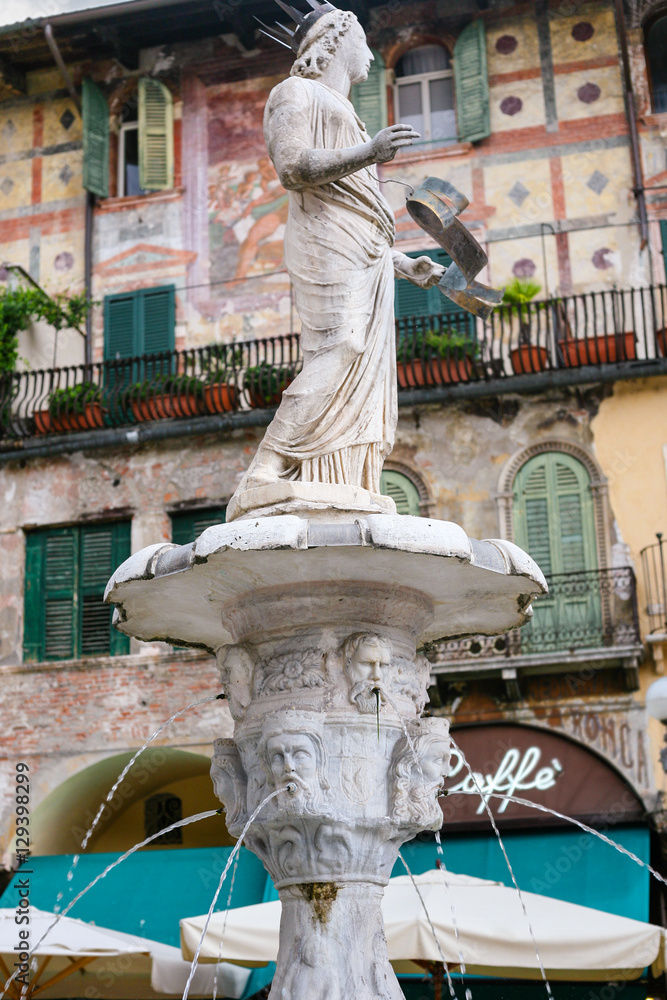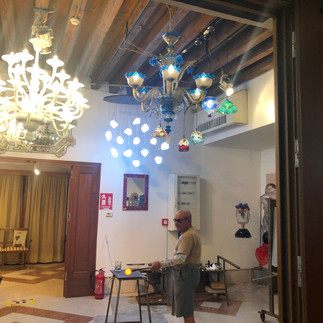Travel: Venice to Verona, (part 1) Italy June 30/2022
- Lili Naveh
- Jun 30, 2022
- 6 min read
The segment travel to Venice starting on June 23rd, and until the 28th, is dedicated to the visit in the 2022 Biennale Arte, (work in progress)
Departing Venice
Venice has 400 bridges. The saddest is the Bridge of Sighs connecting, the Doge’s Palace, to a Prison house via Ponte Dei Sospiri.. believing thta the name was given to the bridge due to the frequent and sole hearer of the sighs of prisoners who had to cross in order to be jailed, and the constant wails and moans.
The Bridge of Sighs - Ponte Dei Sospiri


On our last morning in Venice, when wondering the narrow allies, incidentally David and I stumbled, few canals awy, from the hotel, into a Venetian Glass Blowing center , specially demonstrating this artisan to group of tourists, short in time to actually make it to the Murano island itself.
It was packed with visitors who pre-booked the tour a head of time, all eager to view the demonstration and more so to buy the beautiful glass at the 3 stories shop attached. .

At the check-out time from the Palace Bonevecchiati hotel , a husky upbeat Philippine porter, whom the hotel pre-ordered to our request, showed up with his trolley, to carry our growing luggage to the Vaporetto, which dropped us at Venice main Train Station.

The Train Ride to Verona

It takes only an hour and 20 minutes to ride the train from Venice to Verona, and most of the ride passes through an ugly industrial areas. And later the colors turned green.


Only when getting closer to Verona , the scenery changes and the landscape turns into greener farm land and beautiful vine fields.
Getting to Verona

The Adige River within which Verona is enclosed

The wide river one encounters, when entering the old town is a remarkable site.
The Adiges is the second-longest river in Italy, after the Po. It rises in the Alps near the Italian border with Austria and Switzerland, and flows 410 km through most of northeastern Italy to the Adriatic Sea.
The level of the water was quite low this summer and the color of the water is unappealing brown muddy
Declared UNESCO World Heritage Site in 2000 thanks to its huge artistic and cultural heritage, the city of Verona attracts millions of visitors from all the world.

The Romans who founded the city applied the typical urban scheme based on the military camp:
a square plan surrounded by walls, parallel and perpendicular streets forming a regular grid.
The 2 main avenues :cardo massimo and decumanus massimo crossed each other in the center, giving life to the forum, the square that was the heart of the social, economic and religious life of every Roman city. (Roman Road)
2000 years later the forum is still there: Piazza delle Erbe.
Piazze delle Erbe - Herbs Square, painting by Angelo Dall’Oca Bianca (1858-1942)
The ancient Roman forum of Verona

Its majestic Arena , noble palaces, elegant squares – including first of all Piazze delle Erbe, Piazza Bra and Piazza dei Signori , its historical past of the Roman Age, the Early Middle Ages, Republic of Venice and Renaissance, and its imposing Castelvecchio, symbol of the Scaliger dominion, are all points of attraction
Grand Square Piazze delle Erbe,
The ancient town hall, the Torre dei Lamberti, the Casa dei Giudici ("Judges' Hall") and the frescoed Mazzanti Houses at the North side of the Piazza.
Baroque Palazzo Maffei, with a restaurant and a museum decorated by statues of Greek gods. facing the white marble column, on which is St. Mark's Lion, symbol of the Republic of Venice. now under construction, is seated.
Below it the site of the ancient Roman Capitol Hill, looking towards the forum, which is occupies by market and trinkets stands, as well fashionable stores.
Casa dei Mercanti ("House of the Merchants", also known as Domus Mercatorum), now the seat of the Banca Popolare di Verona. and other buildings, - tall houses of the Jewish Ghetto, are all reminiscent of medieval tower-houses.


Most ancient monument is the fountain (built in 1368 by Cansignorio della Scala), surmounted by a statue called Madonna Verona, which is however a Roman sculpture dating to 380 AD
Michele Sanmicheli, (born 1484, San Michele, Verona, Republic of Venice [Italy]—died 1559, Venice), and a contemporary of Palladio iwas a Mannerist architect, especially noted for his original treatment of military fortifications. In 1527 Sanmicheli began to transform the fortifications of Verona according to the newer system of triangular corner bastions,.All fortified gates in Verona, are among his best works.
He was a pupil of his father, Giovanni, and his uncle Bartolomeo, both architects in Verona.

But most Verona is known ,of course for its romantic legendary reputation, that links the name of Verona to that of Romeo and Juliet, making it the city of love by definition.
.
The hotel at the Romantic Courtyard

David made sure to book us at this most charming small boutique hotel right inside the courtyard of Casa di Giulietta Museum
Relais Balcone di Giulietta Hotel
via Cappello, 23 Verona
hello@balconedigiulietta.com 39 3407359242
A precious residence, of 16 elegantly furnished rooms, housed in the courtyard that overlooks the most famous balcony in the world: that of the love story of Romeo and Juliet at the heart of downtown off Piazza delle Erbe
Make sure to request a room on one level only (not on 2 levels) and there is NO access to cars, so the closest one can get to the hotel, is via Piazza Viviani
The Entrance from Cappello St to Casa di Giulietta

The mobbed Courtyard..


The courtyard is full of visitors all day long, from 9:00am to 7:00pm when the iron gate closes, and only the hotel's guests, the lucky ones, are privileged to the gate's key. and can view the famous balcony all day long,
.
The view from the Balcony
We were also privileged to visit the museum, first thing in the morning, before the crowds arrived, and the museum was empty off people.
The House - Museum a medieval complex of structures, was restored in 1938 from the Verenosa 13c decorative era and has attracted pilgrimage throughout the centuries.
Casa di Giulietta Museum located on Via Cappello
The Capulet family’s houses were not actually located here, but rather in the vicinity of the bank of the River Adige. The house today is an attractive brick and stone building with ivy covered garden walls and a small courtyard
So how did a 13th-century house in Verona become linked with Romeo and Juliet for evermore?
The clue is in the name. The house belonged to the Dal Capello family, commonly known as the Cappelletti. This was so similar to the name of Juliet's family, the Capulets that the house became her family home in everyone's imagination and the small balcony overlooking the courtyard. wasn't added until the 20th-c but in the process it gave a great boost to Verona's tourist industry.
The inside of the house is arranged as a small museum with information about the building and Shakespeare's tragedy, Romeo and Juliet. The frescoes, paintings, and ceramics reflect the setting and story of his play while the furniture and furnishings are genuine antiques from the 16th and 17th c .with no evidence, that anything in the house now belonged to either the Capulets or the Cappello family.
And the majestic bed is the one designed by Reznik Mongiardino for Zsffireili's 1968 film adaptation


To climb up to famous white sand stone unnaturally attached balcony, one needs to be an Olympic jumper since there are no gutters nor ladders to get up there…
Sculpture of Giulietta
Just under the balcony stands a copy of the bronze statue of Juliet. (1969) The original statue was made by the Veronese sculptor Nereo Costantini (1905-1969)

Legend has it that rubbing your hand over Juliet's right breast brings love and fertility.
The "Tomba of Giulietta" Cappeletti's property
+39 333 2199 645 info@veronissima.com

The Romeo and Juliet of the Orient
Statue of Liang Shambo and Zhu Yingtai.

The path leading to the property



The tomb is a stone sarcophagus, empty and without a lid. It is inside the underground crypt/ vaults of the Abbey/ Church of San Francesco al Corso,(1230)
According to William Shakespeare’s play "Romeo and Juliet" were buried here. Soon after Shakespeare wrote his love story, a real sarcophagus for the lovers was placed in the courtyard of the monastery. The lid of the sarcophagus and the remains inside were taken to a secret location by the Venetian government because they didn’t want the two suicides to have too much public attention.
The Tomb itself

Museo degli Affreschi- Frescoes Museum
Under Juliet’s tomb, the monastery houses the Museo degli Affreschi, the frescoes museum, which opened in 1975 and contains numerous frescoes from the palaces of Verona from the 16th to the 18th c. In the courtyard and basement there are sculptures and amphorae from Roman times.
At the museum's court yard

The Scaligeri Family
The Della Scala family, whose members were known as Scaligeri was the ruling family of Verona and mainland Veneto (except for Venice) from 1262 - 1387,[ for a total of 125 years, left their marks on the city's walls, churches and also at the La Scala music hall
in Milan. The church of Santa Maria Antica in Verona is surrounded with the tombs (arche) of the Scaligeri in the form of Gothic shrines
From 1835 until 1866 Verona was under the Austrian-Hungarian rule, with which it also had close economic ties even before, and that influence is notice in the architecture from that period.
+++++++++++++++++++++++++
Verona's Restaurants we sampled
Restaurante Arche
Via Arche Scaligere, 6 045 800 7415
Piazza Broilo, 1, 045 801 5292
Restaurante Vittorio Emanuele (by the Arena)
P.za Bra, 16, 045 923 5850
Restaurante Torocolo (by the Arena)
Via Carlo Cattaneo, 11, 045 803 3730
Iginio Massari - Alta Pasteticceria Best Patiserie (off Piazze delle Erbe)
Corso Sant'Anastasia, 13, 045 978 9991
To be Continued...



























Comments